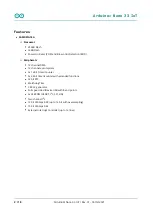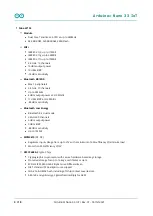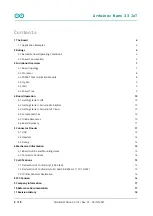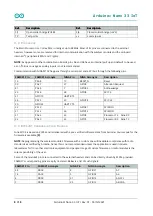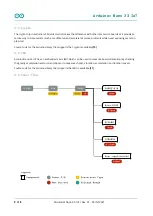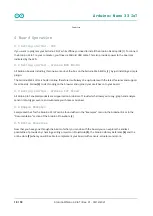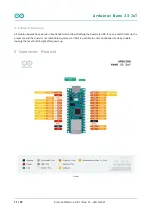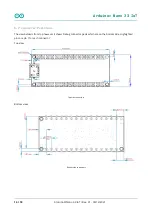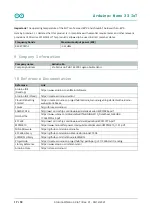
Arduino® Nano 33 IoT
8 / 18
Arduino® Nano 33 IoT / Rev. 01 - 06/12/2021
Ref.
Description
Ref.
Description
Ref.
Description
Ref.
Description
SJ1
Open solder bridge (VUSB)
SJ4
Closed solder bridge (+3V3)
TP
Test points
xx
Lorem Ipsum
3.2 Processor
The Main Processor is a Cortex M0+ running at up to 48MHz. Most of its pins are connected to the external
headers, however some are reserved for internal communication with the wireless module and the on-board
internal I
2
C peripherals (IMU and Crypto).
NOTE: As opposed to other Arduino Nano boards, pins A4 and A5 have an internal pull up and default to be used
as an I
2
C Bus so usage as analog inputs is not recommended.
Communication with NINA W102 happens through a serial port and a SPI bus through the following pins.
SAMD21 Pin
SAMD21 Acronym
NINA Pin
NINA Acronym
Description
13
PA08
19
RESET_N
Reset
39
PA27
27
GPIO0
Attention Request
41
PA28
7
GPIO33
Acknowledge
23
PA14
28
GPIO5
SPI CS
21
GPIO19
UART RTS
24
PA15
29
GPIO18
SPI CLK
20
GPIO22
UART CTS
22
PA13
1
GPIO21
SPI MISO
21
PA12
36
GPIO12
SPI MOSI
31
PA22
23
GPIO3
Processor TX Nina RX
32
PA23
22
GPIO1
Processor RX Nina TX
3.3 WiFi/BT Communication Module
Nina W102 is based on ESP32 and is delivered with a pre-certified software stack from Arduino. Source code for the
firmware is available [9].
NOTE: Reprogramming the wireless module’s firmware with a custom one will invalidate compliance with radio
standards as certified by Arduino, hence this is not recommended unless the application is used in private
laboratories far from other electronic equipment and people. Usage of custom firmware on radio modules is the
sole responsibility of the user.
Some of the module’s pins are connected to the external headers and can be directly driven by ESP32 provided
SAMD21’s corresponding pins are aptly tri-stated. Below is a list of such signals:
SAMD21 Pin
SAMD21 Acronym
NINA Pin
NINA Acronym
Description
48
PB03
8
GPIO21
A7
14
PA09
5
GPIO32
A6
8
PB09
31
GPIO14
A5/SCL
7
PB08
35
GPIO13
A4/SDA


